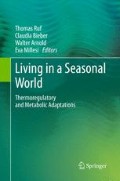Abstract
Climate change will not only directly affect climatic parameters, such as temperature and precipitation, but ultimately also ecological and physiological parameters of animal species. Our study investigates the effects of variation in climatic conditions, as experienced by climate change, on hibernation physiology and energy balance of a small hibernating mammal, the hazel dormouse (Muscardinus avellanarius). To understand whether ambient conditions indeed impact thermoregulatory patterns (frequency of arousals) and energy budgets during hibernation, we measured skin temperature and metabolic rate of M. avellanarius under natural conditions during two winters of different strengths. Our results show that environmental conditions did significantly alter hibernation parameters in M. avellanarius at different levels. M. avellanarius did not compensate for changes in ambient temperature, but body temperature followed ambient temperature for most of the hibernation season (with skin temperature down to −2.9°C). Arousals occurred more frequently during warmer months, also after seasonal effects were eliminated, causing substantial additional energy expenditure. We conclude that hibernating small mammals such as M. avellanarius are more likely to deplete fat reserves before the end of hibernation when temperatures increase, due to generally increased body temperature (and thus energy expenditure) during hibernation, and an increase in arousal frequency.
Access this chapter
Tax calculation will be finalised at checkout
Purchases are for personal use only
References
Barnes BM (1989) Freeze avoidance in a mammal: body temperatures below 0°C in an Arctic hibernator. Science 244:1593–1595
Bright PW, Morris PA (1996) Why are dormice rare? A case study in conservation biology. Mammal Rev 26:157–187
Corp N, Gorman ML, Speakman JR (1997) Seasonal variation in the resting metabolic rate of male wood mice Apodemus sylvaticus from two contrasting habitats 15 km apart. J Comp Physiol B 167:229–239
Dausmann KH (2005) Measuring body temperature in the field—evaluation of external vs. implanted transmitters in a small mammal. J Therm Biol 30:195–202
Dausmann KH, Glos J, Ganzhorn JU, Heldmaier G (2004) Hibernation in a tropical primate. Nature 429:825–826
Dausmann KH, Glos J, Ganzhorn JU, Heldmaier G (2005) Hibernation in the tropics: lessons from a primate. J Comp Physiol B 175:147–155
Dausmann KH, Glos J, Heldmaier G (2009) Energetics of tropical hibernation. J Comp Physiol B 179:345–357
Florant G, Heller H (1977) CNS regulation of body temperature in euthermic and hibernating marmots (Marmota flaviventris). Am J Physiol Regul Integr Comp Physiol 232(5):R203–R208
Geiser F (2007) Yearlong hibernation in a marsupial mammal. Naturwissenschaften 94:941–944
Geiser F, Broome LS (1993) The effect of temperature on the pattern of torpor in a marsupial hibernator. J Comp Physiol B 163:133–137
Geiser F, Kenagy GJ (1988) Torpor duration in relation to temperature and metabolism in hibernating ground squirrels. Physiol Zool 61(5):442–449
Geiser F, Ruf T (1995) Hibernation versus daily torpor in mammals and birds: physiological variables and classification of torpor patterns. Physiol Zool 68:935–966
Geiser F, Hiebert S, Kenagy GJ (1990) Torpor bout duration during the hibernation season of two sciurid rodents: interrelations with temperature and metabolism. Physiol Zool 63:489–503
Guirguis K, Gershunov A, Schwartz R, Bennett S (2011) Recent warm and cold daily winter temperature extremes in the Northern Hemisphere. Geophys Res Lett 38:L17701. doi:10.1029/2011GL048762
Heldmaier G, Neuweiler G (2004) Vergleichende Tierphysiologie. Springer, Heidelberg
Heldmaier G, Ruf T (1992) Body temperature and metabolic rate during natural hypothermia in endotherms. J Comp Physiol B 162:696–706
Heller HC, Hammel HT (1972) CNS control of body temperature during hibernation. Comp Biochem Physiol 41A:349–359
Humphries MM, Thomas DW, Speakman JR (2002) Climate-mediated energetic constraints on the distribution of hibernating mammals. Nature 418:313–316
Humphries MM, Kramer DL, Thomas DW (2003) The role of energy availability in mammalian hibernation: an experimental test in free-ranging eastern chipmunks. Physiol Biochem Zool 76(2):180–186
Juškaitis R (2006) Interactions between dormice (Gliridae) and hole-nesting birds in nestboxes. Folia Zool 55(3):225–236
Juškaitis R (2008) The common dormouse, Muscardinus avellanarius. Ecology, population structure and dynamics. Institute of Ecology of Vilnius University Publishers, Vilnius
McNab BK (1971) On the ecological significance of Bergman’s rule. Ecology 52:845–854
Mills AM (2005) Changes in the timing of spring and autumn migration in North American migrant passerines during a period of global warming. Ibis 147:259–269. doi:10.1111/j.1474-919X.2005.00380.x
Pretzlaff I, Kerth G, Dausmann KH (2010) Communally breeding bats use physiological and behavioural adjustments to optimise daily energy expenditure. Naturwissenschaften 97:353–363. doi:10.1007/s00114-010-0647-1
Saino N, Rubolini D, Lehikoinen E, Sokolov LV, Bonisoli-Alquati A, Ambrosini R, Boncoraglio G, Møller AP (2009) Climate change effects on migration phenology may mismatch brood parasitic cuckoos and their hosts. Biol Lett 5:539–541. doi:10.1098/rsbl.2009.0312
Soivio A, Tähti H, Kristoffersson R (1968) Studies on the periodicity of hibernation in the hedgehog (Erinaceus europaeus L.). Ann Zool Fenn 5:224–226
Speakman JR, Thomas DW (2003) Physiological ecology and energetics of bats. In: Kunz TH, Fenton BM (eds) Bat ecology. University of Chicago Press, Chicago, pp 430–490
Thomas DW, Dorais M, Bergeron JM (1990) Winter energy budgets and cost of arousals for hibernating little brown bats, Myotis lucifugus. J Mammal 71:475–479
Willis JS (1982) The mystery of periodic arousal. In: Lyman CP, Willis JS, Malan A, Wang LCH (eds) Hibernation and torpor in mammals and birds. Academic Press, New York, pp 92–103
Wojciechowski MS, Jefimow M, Tegowska E (2007) Environmental conditions, rather than season, determine torpor use and temperature selection in large mouse-eared bats (Myotis myotis). Comp Biochem Physiol A 147:828–840
Acknowledgments
The study has been carried out under licence from the “Landesamt für Naturschutz und Umwelt Schleswig–Holstein”. We gratefully acknowledge their support and that of the local department of forestry. The “Deutsche Forschungsgemeinschaft (DFG)” provided financial support.
Author information
Authors and Affiliations
Corresponding author
Editor information
Editors and Affiliations
Rights and permissions
Copyright information
© 2012 Springer-Verlag Berlin Heidelberg
About this chapter
Cite this chapter
Pretzlaff, I., Dausmann, K.H. (2012). Impact of Climatic Variation on the Hibernation Physiology of Muscardinus avellanarius . In: Ruf, T., Bieber, C., Arnold, W., Millesi, E. (eds) Living in a Seasonal World. Springer, Berlin, Heidelberg. https://doi.org/10.1007/978-3-642-28678-0_8
Download citation
DOI: https://doi.org/10.1007/978-3-642-28678-0_8
Published:
Publisher Name: Springer, Berlin, Heidelberg
Print ISBN: 978-3-642-28677-3
Online ISBN: 978-3-642-28678-0
eBook Packages: Biomedical and Life SciencesBiomedical and Life Sciences (R0)

